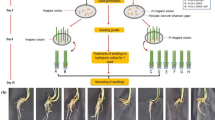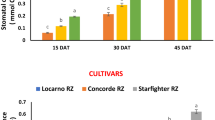Abstract
Dry matter accumulation, photosynthate partitioning and chlorophyll retention by Asiatic lily cultivars “Serreda” and “Navona” were evaluated under two sources of nitrogen, urea as NH4 − and calcium nitrate as NO3 −, applied at the rate of 40 g m−2 (as N). The fertilizers were applied in 2, 3 and 4 equal splits at 30, 60 75 and 90 days after planting (DAP). Nitrogen in the form of calcium nitrate significantly improved relative growth rate (RGR), net assimilation rate (NAR), net chlorophyll content and leaf area throughout the growth period. Nitrogen application was advantageous as 3 and 4 split applications and significantly improved RGR, NAR and net chlorophyll content, thus helping export of photosynthates to bulbs as well as chlorophyll retention in the 105 DAP period. The results of the present study showed that the cultivar “Serreda” was having better growth than the cultivar “Navona” in terms of dry matter accumulation, chlorophyll retention, leaf area and photosynthetic partitioning. Nitrate was significantly superior in improving plant growth, leaf area, dry matter accumulation and net chlorophyll content. Application of 40 g N m−2 in three (S2) and four (S3) split applications significantly improved overall growth and yield.




Similar content being viewed by others

Abbreviations
- cv:
-
Cultivar
- DAP:
-
Days after planting
- DMSO:
-
Dimethyl sulfoxide
- LAI:
-
Leaf area index
- NAR:
-
Net assimilation rate
- N:
-
Nitrogen
- RGR:
-
Relative growth rate
References
Aoki N, Yoshino S (1988) Studies on the flower production of bulbous plants under computer controlled system. (7) Effects of the amount of dry matter production and the quality of cut flowers of semi-forced lilies. Bull Fac Agric 22:37–42
Arnon D (1949) Copper enzymes in isolated chloroplasts, polyphenoxidase in beta vulgaris. Plant Physiol 24:1–15
Dole JM, Wilkins HF (2005) Floriculture: principles and species, 2nd edn. Prentice Hall, Upper Saddle River
Grassotti A, Gimelli F (2011). Bulb and cut flower production in the genus lilium: current status and the future. In: Grassotti A, Burchi G (eds) Proceedings of 2nd international seminar on genus lilium. Acta Horticulturae Vol 900, pp 21–35
Hamaiel AF, Abd-El-Naby HM, El-Gamiely E (1995) Effect of sources and rates of nitrogen on vegetative growth, and yield of Broccelin. Kohlrabi and Table Beet. J Agric Sci Mansoura Univ 20:3831–3840
Kandil AA, Leilah AA, Mostafa AK, Fathalla FH (2010) Study on the internal bulb quality of some new Egyptian onion cultivars under different irrigation regimes. J Plant Prod Mansoura Univ 1:205–212
Karimi V, Hatamzadeh A, Asil MH, Samizadeh H (2012) An evaluation of effects of calcium nitrate and IBA on quality and quantity of two cultivars of lily cut flower. Iran J Hortic Sci 43:79–89
Kawagishi K, Miura T (1996) Growth characteristics and effect of nitrogen and potassium topdressing on thickening growth of bulbs in spring planted edible lily (Lilium leichtlinii var. maximowiczii Baker). Jap J Crop Sci 65:51–57
Mishu HM, Ahmed F, Rafii MY, Golam F, Latif MA (2013) Effect of sulphur on growth, yield and yield attributes in onion (Allium cepa L.). Aust J Crop Sci 7:1416–1422
Mohanty CR, Mishra M, Mohapatra A, Misra RL (2002) Effect of nitrogen and weeding on tuberose. Floriculture research trend in India. In: Sanyat M (ed) Proceedings of the national symposium on Indian floriculture in the new millennium, Lal Bagh, Bangalore, pp 340–342
Nazki IT, Arora JS (2000) Effect of GA3 and nitrogen on gladiolus. J Ornam Hortic 3:124–127
Nonnecke IL (1989) Vegetable production. Van Nostrand Reinhold, New York
Pandey RK, Dogra S, Sharma JP, Jamwal S (2008) Evaluation of Asiatic hybrid lily cultivars under subtropical conditions of Jammu region. J Plant Sci Res 24:213–214
Pandey RK, Dogra S, Jamwal S, Bhat D (2010) Performance of Asiatic lily hybrids under Jammu conditions. Environ Ecol 28:775–776
PT/BKD (2010) Lelie, Beplante oppervlakten bloembollen 2009 en 2010. Rapport nr. 47, 1–18.www.bloembollenkeuringsdienst.nl. c.f Bulb and cut flower production in the genus lilium: current status and the future. In: Grassotti A, Burchi G (eds) Proceedings of 2nd international Seminar on Genus lilium. Acta Horticulturae 900: 21–35
Radford PJ (1967) Growth analysis formulae. Their use and abuse. Crop Sci 7:171–175
Salazar O, Valdez A, Marquina T, Grassotti A (2011) Calcium affects quality and nutrition of cut lily flowers. Acta Horticulturea 900:113–117
Sanchez MEA, Torres RM, Mateos RG (2008) Calcium supply in the development and nutrition of Asiatic lilium. Agrocienca 42:881–889
Su D, Zheng F, Ying-li LI, Bin Z (2012) Effect of different NH4 +–N:NO3 −–N ratios on the growth of lilium. North Hortic 2:67–69
Zhu Q, Pan Y, Zhao L (2012) The effects of N, P, K, and Ca on plant growth and nutrient content of lily leaves. Acta Prataculturae Sinica 21:274–284
Acknowledgments
The authors wish to thank Sher-e-Kashmir University of Agricultural Sciences and Technology of Kashmir (SKUAST-K) for financial support.
Author information
Authors and Affiliations
Corresponding author
Rights and permissions
About this article
Cite this article
Wani, M.A., Nazki, I.T., Din, A. et al. Photosynthate Partitioning in Asiatic Lilies Under Ammoniacal and Nitrate Sources of Nitrogen. Agric Res 5, 230–235 (2016). https://doi.org/10.1007/s40003-016-0222-x
Received:
Accepted:
Published:
Issue Date:
DOI: https://doi.org/10.1007/s40003-016-0222-x



